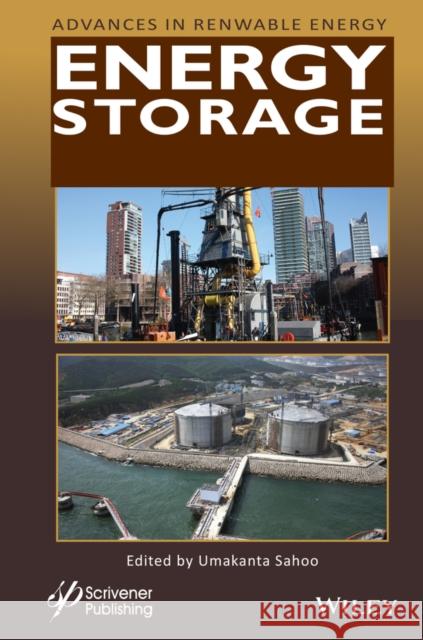Energy Storage » książka



(netto: 910,45 VAT: 5%)
Najniższa cena z 30 dni: 950,08
ok. 30 dni roboczych
Dostawa w 2026 r.
Darmowa dostawa!
List of Contributors xiPreface xiii1 Thermal Energy Storage Systems for Concentrating Solar Power Plants 1Dr. Pratibha Biswal1.1 Introduction 21.2 Concentrating Solar Power (CSP) Technology 21.2.1 CSP Receiver Concepts 41.2.1.1 Parabolic Trough System 41.2.1.2 Linear Fresnel Reflector Systems 51.2.1.3 Central Receiver Plants 61.2.1.4 Dish System 71.3 Thermal Energy Storage in CSP 71.3.1 Active Two-Tank System 91.3.1.1 Active Two-Tank Direct 91.3.2 Active Single-Tank Thermocline 201.3.3 Other TES Systems 211.3.3.1 Packed-Bed Storage System 211.3.3.2 Passive Thermal Storage System 221.3.4 Types of Thermal Energy Storage (TES) 221.3.4.1 Sensible Energy Storage 221.3.4.2 Latent Heat Storage 241.3.4.3 Thermochemical Energy Storage 251.4 Corrosion Problem in TES-CSP System 261.5 Conclusion 26References 272 Solar Thermal Power Plant with Thermal Energy Storage 31Anil Kumar, Umakanta Sahoo and BK Jayasimha Rathod2.1 Introduction 322.2 Literature Review 392.2.1 Power Installed Capacity of India 392.2.2 Energy Storage Systems 402.2.3 Thermal Storage Systems 402.3 Energy Demand of World 442.4 Experimental Set Up 482.4.1 Description of Experimental Set Ups 492.5 Experimental Data Analysis, Results and Discussions 552.5.1 Performance of Reflector Round the Year (Experimental Set up I) 582.5.1.1 Simulation Results 632.5.1.2 Typical PID of a Solar Module from 'India One' Solar Power Plant 662.5.1.3 Quantity of Steam to Turbine 672.6 Experimental Data Analysis, Results and Discussions 692.7 Conclusions 75Symbols 76Acknowledgement 77References 773 Efficient Energy Storage Systems for Wind Power Application 81Pradeep Kumar Sahu, Satyaranjan Jena and Umakanta Sahoo3.1 Introduction 823.2 Energy Storage Devices 843.2.1 Electrical Energy Storage 843.2.1.1 Superconducting Magnetic Energy Storage (SMES) 853.2.1.2 Super capacitors 863.2.2 Mechanical Energy Storage 873.2.2.1 Flywheel Energy Storage (FES) 873.2.2.2 Pumped Hydroelectric Storage (PHS) 883.2.2.3 Compressed Air Energy Storage 893.2.3 Chemical Energy Storage 893.2.3.1 Battery Storage System (BSS) 903.2.3.2 Fuel Cells 903.2.3.3 Solar Fuel 903.2.4 Thermal Energy Storage 933.3 Hybrid Energy Storage System (HESS) 933.4 Power Converter Topologies for Hybrid Energy Storage 953.4.1 Passive Topology 953.4.2 Semi-Active Topology 973.4.3 Active Topology 973.4.4 Comparison of Different Topologies 983.5 HESS Energy Management and Control 993.5.1 HESS Control Schemes 993.5.1.1 Classical Control Scheme 1003.5.1.2 Intelligent Control Schemes 1023.5.2 Comparison of Different Control Schemes 1033.6 Applications of the Storage Technologies in Wind Power 1043.6.1 Power Fluctuation Mitigation 1043.6.2 Low Voltage Ride Through (LVRT) 1053.6.3 Voltage Control Support 1053.6.4 Oscillation Damping 1063.6.5 Peak Shaving 1063.6.6 Spinning Reserve 1073.6.7 Time Shifting 1083.6.8 Transmission Line Curtailment 1083.6.9 Load Following 1093.6.10 Unit Commitment 1103.7 Conclusion 110References 1124 Advances in Electrochemical Energy Storage Device: Supercapacitor 119Swagatika Kamila, Bikash Kumar Jena and Suddhasatwa Basu4.1 Introduction 1204.2 Types of Energy Storage Devices 1204.3 Overview of Supercapacitor and Its Global Scenario 1224.4 Status of Supercapacitor in India 1254.5 Types of Supercapacitor According to the Energy Storage Mechanism 1264.5.1 Electrical Double-Layer Capacitor (EDLC) 1264.5.2 Pseudocapacitor 1284.5.3 Hybrid Supercapacitor 1294.5.3.1 Composite Supercapacitor 1294.5.3.2 Asymmetric Supercapacitor 1304.5.3.3 Battery Type 1304.6 Basic Components of Supercapacitor 1304.6.1 Current Collector 1304.6.2 Electrode Materials 1314.6.2.1 EDLC Materials 1314.6.2.2 Pseudocapacitive Materials 1324.6.3 Electrolytes 1384.6.4 Binders 1384.6.5 Separators 1394.7 Conclusion 140References 1405 Thermal Energy Storage Systems for Cooling and Heating Applications 149Pankaj Kalita, Debangsu Kashyap and Urbashi Bordoloi5.1 Introduction 1505.2 Classification of Storage Systems 1515.3 Sensible Heat Storage 1515.3.1 Water-Based Storage 1535.3.2 Packed Beds 1565.3.3 Aquifers 1585.3.4 Borehole 1605.4 Latent Heat Storage 1635.4.1 Enhancement Methods for Thermal Conductivity Enhancement 1645.4.1.1 Macro and Microencapsulation 1655.4.1.2 Addition of Fins 1665.4.1.3 Multiple PCM Technology 1675.4.1.4 Immersion Through Material Pores 1675.5 Thermochemical Heat Storage 1685.5.1 Absorption Cycle 1725.5.2 Adsorption Cycles 1735.5.3 Chemical Reaction 1745.6 Application of Thermal Energy Storage Systems 1765.6.1 Absorption Refrigeration System 1765.6.2 Solar Pumps Application in Space Cooling/Heating 1775.6.3 Solar Pond Integrated Packed-Bed TES System for Space Heating 1785.6.4 Solar FPC 1795.6.5 Solar PV/T 1815.6.6 Solar Air Heater 1835.7 Design Problems 1845.8 Conclusion 196References 1966 Optimistic Technological Approaches for Sustainable Energy Storage Devices/Materials 201Benjamin Raj, Arya Das, Suddhasatwa Basu and Mamata Mohapatra6.1 Introduction 2026.2 Advancements in Supercapacitor Technology 2026.2.1 The Current Global Supercapacitor Market 2056.2.2 Challenges: From Lab to Market 2076.2.3 Current Trends and Opportunities 2096.2.4 Composites and Novel Architectures 2096.2.5 Microsupercapacitors 2106.2.6 Hybrid Supercapacitors 2116.2.7 Flexible, Wearable and Smart Supercapacitors 2116.3 Advancements in Battery Technology 2126.3.1 Challenges 2136.3.2 Nickel-Cadmium Batteries 2136.3.3 Nickel-Metal Hydride Batteries 2146.3.4 Lead Storage Battery 2146.3.5 Sodium Sulphur Battery 2156.3.6 Flow Batteries 2176.3.7 Lithium Ion Batteries (LIBs) 2186.4 Conclusion and Outlook 221References 2227 Electro-Chemical Battery Energy Storage Systems - A Comprehensive Overview 229Nikhil P G and G Sivaramakrishnan7.1 Introduction 2297.2 Electro-Chemical Storage Devices 2317.2.1 Definition and Types 2317.2.2 Energy Storage Landscape and Benefits of Electro-Chemical Storage 2357.2.3 Drivers and Barriers in Implementation of Energy Storage Systems 2407.3 Design and Performance Parameters for Electro-Chemical Storage 2407.3.1 Design Basis for Large Storage Application 2407.4 Case Study From Industry 2437.5 Best Practices in Battery Maintenance 2457.6 End of Life Cycle of Batteries 2477.6.1 Major Recyclable Products from the Process 2487.6.2 Disposal Measures 2487.7 India Energy Storage Mission 2497.8 Conclusion 251References 2518 Simulation of Charging and Discharging a Thermal Energy Storage System Involving Phase Change Material 253S. Sanyal, A. Borgohain and S.P. Gupta8.1 Introduction 2538.2 Design of Latent Heat Storage (LHS) System 2568.2.1 Identification of Suitable PCM 2568.2.2 Design of Heat Exchanger 2608.2.3 Performance Evaluation 2618.3 Analysis of Phase Change Systems 2618.4 Simulation 2638.4.1 Equations Involved 2638.4.2 Modelling 2658.4.3 Transient Analysis 2698.5 Results and Discussion 2698.5.1 Scalability of Mesh 2698.5.2 Melting 2708.5.3 Solidification 2718.5.4 Performance 2738.6 Conclusion 274Acknowledgement 274Abbreviation 275References 275Index 277
Umakanta Sahoo, PhD, is a research scientist at the National Institute of Solar Energy, India. He received his PhD in mechanical engineering at Delhi Technological University, Delhi, India. He has vast research experience in the field of solar energy and biomass. He is the author of many research papers in international journals and books in renewable energy and mechanical engineering. He has conducted numerous training on designing, operation and maintenance of solar energy systems, and he is the author of several books on renewable energy also available from Wiley-Scrivener.
1997-2025 DolnySlask.com Agencja Internetowa
KrainaKsiazek.PL - Księgarnia Internetowa









